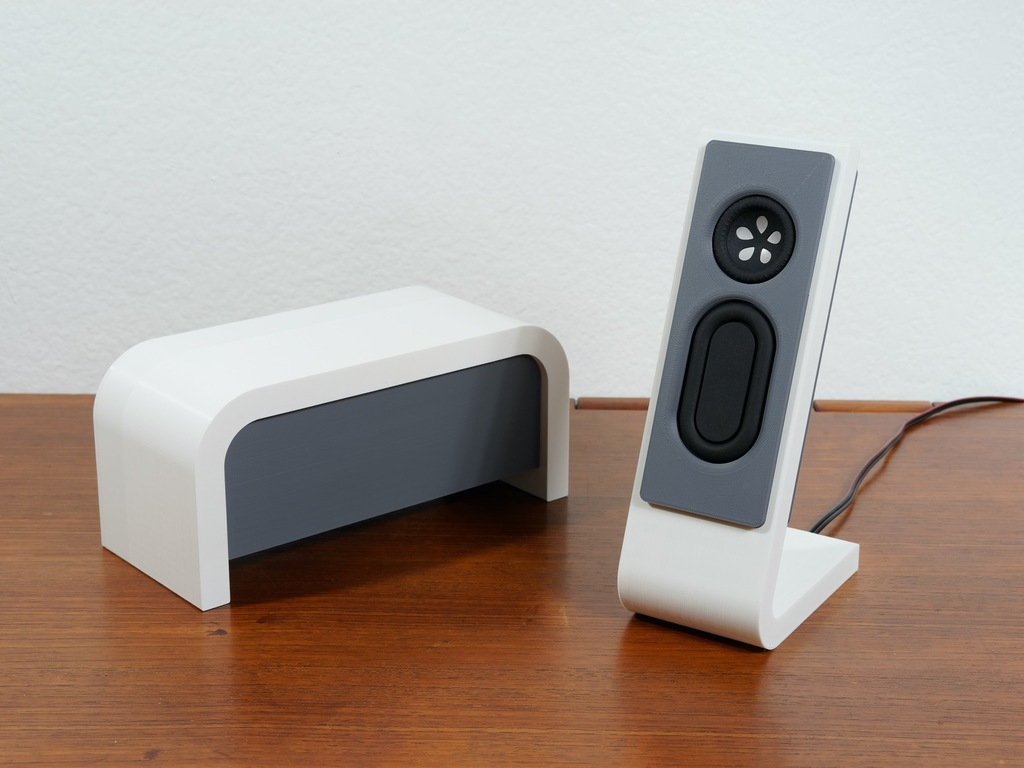
ZX82 2.1ch Subwoofer & Satellite Loudspeaker System
thingiverse
This amazing compact sub-sat system demands a print area of 200x200mm for the subwoofer, and slightly smaller for the satellites. These employ sealed speaker modules from Tang Band; the full range T1-2121SD in the satellites, and the T2-2181SA subwoofer module. It's an extremely user-friendly build, requiring no external circuitry or tuning, and the quality of the 3D Print is not crucial to sound quality. The usable frequency range spans 50Hz to 16kHz. I've attached a frequency response curve, measured in my office under imperfect conditions. At present, the modules are approximately $30 USD each, and are available from Parts Express: https://www.parts-express.com/tang-band-t1-2121sd-speaker-module-5-7-16-x-2-3-16--264-948 https://www.parts-express.com/tang-band-t2-2181sa-2-subwoofer-module-6-7-8-x-2-3-4--264-940 The satellites print in three parts; the stand, the back cover, and the decorative trim. The back screws into the stand (2x M3 screws), securing the module in place. The trim can be glued to the front or held with bluetack, allowing you to swap out colors. The speaker cable feeds through a channel in the body and exits via a hole at the rear. To prevent rattles, use a few blobs of bluetack between the speaker and the stand, and the speaker and the back cover. You must solder the wires to the terminals on the module. Some support is required for the "stand" component. Ensure your slicer does not insert support in the cable channel. The subwoofer prints in two parts which screw together, clamping the module (6x M3 screws). You need to remove the existing mounting tabs from the module. Use bluetack between the module and the frame to prevent rattling, with a clearance of 1mm for this purpose. Apply enough bluetack to fill that gap. You will require additional weight inside the top of the subwoofer or use bluetack to hold it down, otherwise it will move about on the table. (There are some M3 holes within the top surface to fix things there if needed.) You must solder the wires to the terminals on the module. I recommend a standard 2.1 channel class D amplifier with the crossover around 150Hz. The subwoofer power handling will increase if you also use a high pass filter at about 50Hz, but this is not essential. These speaker modules are remarkably good for their price and very suitable for desktop use due to their uniform sound distribution. The full range units have a peak in response around 14kHz, which may sound either crisp or tinny, depending on your perspective. Utilize your equalizer to push the response down slightly above 10kHz, and you'll discover they can sound very natural. For an amplifier, consider this: https://www.amazon.com/Nobsound-TPA3116D2-Amplifier-Independent-Adjustment/dp/B074J9X3P5/ or this: https://www.parts-express.com/21-hi-fi-class-d-audio-amplifier-board-2-x-15w-30w-10-18-vdc--320-608
With this file you will be able to print ZX82 2.1ch Subwoofer & Satellite Loudspeaker System with your 3D printer. Click on the button and save the file on your computer to work, edit or customize your design. You can also find more 3D designs for printers on ZX82 2.1ch Subwoofer & Satellite Loudspeaker System.
